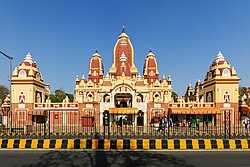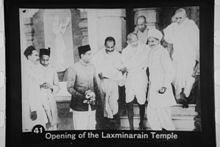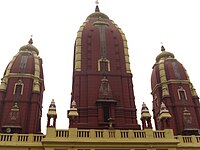इण्डिया गेटIndia Gate
The India Gate, (originally called the All India War Memorial), is a war memorial located astride the Rajpath, on the eastern edge of the ‘ceremonial axis’ of New Delhi, India, formerly called Kingsway. India Gate is a memorial to 82,000 soldiers of the undivided Indian Army who died in the period 1914–21 in the First World War, in France, Flanders, Mesopotamia, Persia, East Africa, Gallipoli and elsewhere in the Near and the Far East, and the Third Anglo-Afghan War. 13,300 servicemen's names, including some soldiers and officers from the United Kingdom, are inscribed on the gate.[1][2] The India Gate, even though a war memorial, evokes the architectural style of the triumphal arch like the Arch of Constantine, outside the Colosseum in Rome, and is often compared to the Arc de Triomphe in Paris, and the Gateway of India in Mumbai. It was designed by Sir Edwin Lutyens.
In 1971, following the Bangladesh Liberation war, a small simple structure, consisting of a black marble plinth, with reversed rifle, capped by war helmet, bounded by four eternal flames, was built beneath the soaring Memorial Archway. This structure, called Amar Jawan Jyoti, or the Flame of the Immortal Soldier, since 1971 has served as India's Tomb of the Unknown Soldier.
History
The India Gate situated in Delhi,was part of the work of the Imperial War Graves Commission (IWGC), which came into existence in December 1917 for building war graves and memorials to soldiers killed in the First World War The foundation stone of the All-India War Memorial was laid on 10 February 1921, at 4:30 PM, by the visiting Duke of Connaught in a solemn soldierly ceremony attended by Officers and Men of the Indian Army, Imperial Service Troops, the Commander in Chief, and Chelmsford, the viceroy.On the occasion, the viceroy said, "The stirring tales of individual heroism, will live for ever in the annals of this country", and that the memorial which was a tribute to the memory of heroes, "known and unknown" would inspire, future generations to endure hardships with similar fortitude and "no less valour".
The King, in his message, read out by the Duke said "On this spot, in the central vista of the Capital of India, there will stand a Memorial Archway, designed to keep" in the thoughts of future generations "the glorious sacrifice of the officers and men of the Indian Army who fought and fell". During the ceremony, the Deccan Horse, 3rd Sappers and Miners, 6th Jat Light Infantry, 34th Sikh Pioneers, 39th Garhwal Rifles, 59th Scinde Rifles (Frontier Force), 117th Mahrattas, and 5th Gurkha Rifles (Frontier Force), were honoured with title of " Royal " in recognition of the distinguished services and gallantry of the Indian Army during the Great War".
Ten years after the foundation stone laying ceremony, on February 12, 1931, the All India War Memorial was inaugurated by Viceroy Lord Irwin, who on the occasion said " those who after us shall look upon this monument may learn in pondering its purpose something of that sacrifice and service which the names upon its walls record."
In the decade between the laying of foundationstone of the War memorial and its inauguration, the rail-line was shifted to run along the Yamuna river, and the New Delhi Railway Station was opened in 1926.
The India gate, which is illuminated every evening, from 19:00 to 21:30, is a major tourist attraction. Motor cars, moved through India Gate, till it was closed to traffic. The Republic Day Parade starts from Rashtrapati Bhavan and passes around the India Gate.
Design
The All-India War Memorial in New Delhi was designed by Edwin Lutyens, who was not only the main architect of New Delhi, but a leading designer of war memorials. He was a member of the IWGC, and one of Europe's foremost designers of war graves and memorials. He designed sixty-six war memorials in Europe, including the highly regarded Cenotaph, in London, in 1919, the first national war memorial erected after World War I, for which he was commissioned by David Lloyd George, the British prime minister. All-India War Memorial in New Delhi, like the Cenotaph, in London, is secular memorial, free of religious and "culturally-specific iconography such as crosses". Lutyens according to his biographer, Christopher Hussey, relied on "elemental Mode", a style of commemoration based on "universal architectural style free of religious ornamentation". The India Gate, which has been called a "creative reworking of the Arc de Triomphe" has a span of 30 feet, and lies on the eastern axial end of Kingsway, present day Rajpath, the central vista and main ceremonial procession route in New Delhi.

Amar Jawan Jyoti
Amar Jawan Jyoti, or the flame of the immortal soldier, is a structure consisting of black marble plinth, with reversed L1A1 Self-loading rifle, capped by war helmet, bound by four urns, each with the permanent light (jyoti) from (CNG) flames, erected under the India Gate in the wake Liberation of Bangladesh in December 1971 to commemorate Indian soldiers killed in the defence of their country. It was inaugurated by the then Prime Minister Indira Gandhi on 26 January 1979, the 23rd Republic Day. Since the installation of the Amar Jawan Jyoti, in 1972, it has served as India's Tomb of the Unknown Soldier. Amar Jawan Jyoti is manned round the clock by soldiers drawn from the three services of the Indian armed forces. Wreaths are placed at the Amar Jawan Jyoti on 26 January, by the Prime Minister of India, and Chiefs of Armed Forces; on Vijay Diwas, and on Infantry Day.[ Infantry Day, is the day Indian Infantry air landed at Srinagar on 27 October 1947 to stop and defeat the Pakistani mercenaries attack on Jammu and Kashmir. 68th Infantry day was marked by ‘Wreath Laying’ ceremony at ‘Amar Jawan Jyoti’ by Chief of Army Staff, Gen Dalbir Singh, and by Lt Gen Chandra Shekhar (Retd) on behalf of Infantry veterans.
Inscriptions
The cornice of the India Gate is inscribed with the Imperial suns while both sides of the arch have INDIA, flanked by the dates MCMXIV (1914 left) and MCMXIX (1919 right). Below the word INDIA, in capital letters, is inscribed:
इण्डिया गेट, (मूल रूप से अखिल भारतीय युद्ध स्मारक कहा जाता है), नई दिल्ली के राजपथ पर स्थित ४३ मीटर ऊँचा विशाल द्वार है। यह स्वतन्त्र भारत का राष्ट्रीय स्मारक है, जिसे पूर्व में किंग्सवे कहा जाता था। इसका डिजाइन सर एडवर्ड लुटियन्स ने तैयार किया था। यह स्मारक पेरिस के आर्क डे ट्रॉयम्फ़ से प्रेरित है। इसे सन् १९३१ में बनाया गया था। मूल रूप से अखिल भारतीय युद्ध स्मारक के रूप में जाने वाले इस स्मारक का निर्माण अंग्रेज शासकों द्वारा उन ९०००० भारतीय सैनिकों की स्मृति में किया गया था जो ब्रिटिश सेना में भर्ती होकर प्रथम विश्वयुद्ध और अफ़ग़ान युद्धों में शहीद हुए थे। यूनाइटेड किंगडम के कुछ सैनिकों और अधिकारियों सहित 13,300 सैनिकों के नाम, गेट पर उत्कीर्ण हैं।लाल और पीले बलुआ पत्थरों से बना हुआ यह स्मारक दर्शनीय है।
जब इण्डिया गेट बनकर तैयार हुआ था तब इसके सामने जार्ज पंचम की एक मूर्ति लगी हुई थी। जिसे बाद में ब्रिटिश राज के समय की अन्य मूर्तियों के साथ कोरोनेशन पार्क में स्थापित कर दिया गया। अब जार्ज पंचम की मूर्ति की जगह प्रतीक के रूप में केवल एक छतरी भर रह गयी है।
भारत की स्वतन्त्रता के पश्चात् इण्डिया गेट भारतीय सेना के अज्ञात सैनिकों के मकबरे की साइट मात्र बनकर रह गया है। इसकी मेहराब के नीचे अमर जवान ज्योति स्थापित कर दी गयी है। अनाम सैनिकों की स्मृति में यहाँ एक राइफ़ल के ऊपर सैनिक की टोपी सजा दी गयी है जिसके चारो कोनों पर सदैव एक ज्योति जलती रहती है। इस अमर जवान ज्योति पर प्रति वर्ष प्रधान मन्त्री व तीनों सेनाध्यक्ष पुष्प चक्र चढ़ाकर अपनी श्रद्धांजलि अर्पित करते हैं। इण्डिया गेट की दीवारों पर हजारों शहीद सैनिकों के नाम खुदे हैं और सबसे ऊपर अंग्रेजी में लिखा हैः
| भारतीय सेनाओं के शहीदों के लिए, जो फ्रांस और फ्लैंडर्स मेसोपोटामिया फारस पूर्वी अफ्रीका गैलीपोली और निकटपूर्व एवं सुदूरपूर्व की अन्य जगहों पर शहीद हुए और उनकी पवित्र स्मृति में भी जिनके नाम दर्ज़ हैं और जो तीसरे अफ़ग़ान युद्ध में भारत में या उत्तर-पश्चिमी सीमा पर मृतक हुए। |
दिल्ली की कई महत्वपूर्ण सड़कें इण्डिया गेट के कोनों से निकलती हैं। रात के समय यहाँ मेले जैसा माहौल होता है।
निर्माण-स्थल का इतिहास
१९२० के दशक तक, पुरानी दिल्ली रेलवे स्टेशन पूरे शहर का एकमात्र रेलवे स्टेशन हुआ करता था। आगरा-दिल्ली रेलवे लाइन उस समय लुटियन की दिल्ली और किंग्सवे यानी राजाओं के गुजरने का रास्ता, जिसे अब हिन्दी में राजपथ नाम दे दिया गया है, पर स्थित वर्तमान इण्डिया गेट के निर्माण-स्थल से होकर गुजरती थी। आखिरकार इस रेलवे लाइन को यमुना नदी के पास स्थानान्तरित कर दिया गया। तदुपरान्त सन् १९२४ में जब यह मार्ग प्रारम्भ हुआ तब कहीं जाकर स्मारक स्थल का निर्माण शुरू हो सका।
४२ मीटर ऊँचे इण्डिया गेट से होकर कई महत्वपूर्ण मार्ग निकलते हैं। पहले इण्डिया गेट के आसपास होकर काफी यातायात गुजरता था। परन्तु अब इसे भारी वाहनों के लिये बन्द कर दिया गया है। शाम के समय जब स्मारक को प्रकाशित किया जाता है तब इण्डिया गेट के चारो ओर एवं राजपथ के दोनों ओर घास के मैदानों में लोगों की भारी भीड़ एकत्र हो जाती है। ६२५ मीटर के व्यास में स्थित इण्डिया गेट का षट्भुजीय क्षेत्र ३०६,००० वर्ग मीटर के क्षेत्रफल में फैला है।
इण्डिया गेट के सामने स्थित वह छतरी अभी भी ज्यों की त्यों है। इस छतरी के नीचे किसी जमाने में जार्ज पंचम की भव्य मूर्ति हुआ करती थी। भारत के आज़ाद होने के बाद उस मूर्ति को सरकार ने वहाँ से हटा कर कोरोनेशन पार्क में स्थापित कर दिया।
प्रति वर्ष गणतंत्र दिवस पर निकलने वाली परेड राष्ट्रपति भवन से शुरू होकर इण्डिया गेट से होते हुए लाल किले तक पहुँचती है।
















 or
or